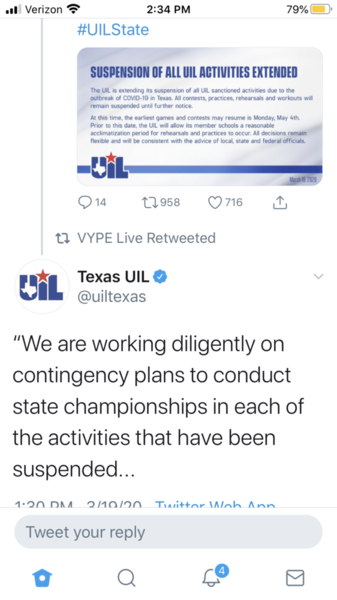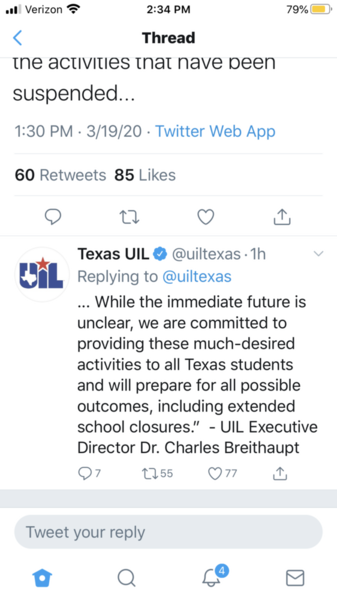With each passing day, as the world gains more experience with the disease, one thing we are learning is that fatality rates are zero for those under 10 and virtually zero for those 11-19.
What this means to me is, the closure of schools and the cessation of school-related activities is not justified by any scientific fact. We're dealing only with an hysterical overreaction.
Before the NCAA just cancelled everything, it had announced that games would proceed but without spectators. If people want to do this to protect older, more vulnerable members of the community, perhaps that is still justifiable. But cancelling practices and games among youths is not justified.
As a nation, we need to stop talking about all the things we can't do or shouldn't do and start identifying things we CAN do. I'm not willing to accept this message that we're all going to have to huddle in our homes for literally months with no interaction. Letting fear ruin all our lives, put millions out of work, cause tens of thousands of businesses to fail and igniting a depression should be off the table as an option.
Midlo, I think you aren't giving enough weight to two important points:
1) Kids can get C-19, including sever cases, although they generally are at lower risk:
"Children, including very young children, can develop COVID-19. However, children tend to experience milder symptoms such as fever, runny nose, and cough. Some children have had severe complications, but this has been less common. Children with underlying health conditions may be at increased risk for severe illness." (https://www.health.harvard.edu...irus-resource-center)
2) More importantly, children who are infected can infect others--parents, grandparents, babysitters, people that happen to be near them on public transit or in the grocery store or church. Take schools as a specific example, since you mentioned them. No school can operate without adults present. Teachers, janitors, administrators, parent volunteers all are adults, some are old enough to be at high risk, and some have underlying health conditions. Even if you conclude the risk to kids themselves is acceptable, closing schools was a measure intended to help everyone by slowing the spread of coronavirus.
I am not a public health expert. But I assume you are not either. Those who do have medical and public health expertise are darn near unanimous in their recommendations at this point.
Chico is 100% correct. Midlo, you are 100% myopic and naive. No, I'm not picking on you.
From someone in the field, with experience, just because kids aren't currently dying or the virus isn't apparently lethal to them, is even more reason for them to be quarantined and kept away from each other and everyone else. They are the perfect vector. Look up what a "vector" is.
Let Me Google That For you.
You are entitled to your opinion, however wrong it is in this case, but come on. "What this means to me is, the closure of schools and the cessation of school-related activities is not justified by any scientific fact. We're dealing only with an hysterical overreaction." WOW!!
If you aren't trained or have any experience, please let the experts lead the way and offer guidance. Otherwise it just sounds silly and naive.
To help exemplify the situation, watch a few simulations and understand how the vector works, and if the vector doesn't show symptoms, it can't be identified, treated, or quarantined to protect the rest of the population. Transmission skyrockets. Self quarantine works, shuts this down, stops the spread.
https://mail.google.com/mail/u...bTWqcJJmXvKVcCNgmhqV
Control what you can control. This is bigger than you, your family, me or mine, and so are the ramifications. People being selfish and not quarantining are only exacerbating and delaying the outcome. This doesn't have legs if you don't give it legs! Take this awful contagion's power away now and often.
Hug your family (when it's safe) and wait it out. This WILL go away sooner the sooner people effectively self-quarantine. Make a list of all you're grateful for and the things you miss most. We're taking in moments we overlooked before, perhaps you are too!
Seems the little things are big now whereas a week ago the big things are little today.
All this takes is everyone to hit the pause button and it stops in MUCH LESS TIME than it will if you don't. This would have been resolved in a matter of weeks with systemic and mandatory self quarantines. Now it will unfortunately take longer as people travel, and go about this without care or caution.
Yes, spring ball is GONE. Hoping summer ball isn't affected, but I'm losing faith in that with every passing day and with ignorant and naive posts.
Knowing the math behind availability of hospitals, hospital beds, ventilators, staff, etc. You don't want this to get out of hand, should you or a loved one, need that bed or ventilator or staff to be alert and awake to treat you and not sick themselves.
Wash your hands and chill.........

YouTube from people that have and are going through this... https://www.youtube.com/watch?reload=9&v=o_cImRzKXOs&feature=emb_share&fbclid=IwAR3u9MgJnCC9yAKOJsomddHSe2dbbUvdj-cseGV4hkYOY_d2m2ALMBoTkxo
Think about more than yourself and your inconvenience......








